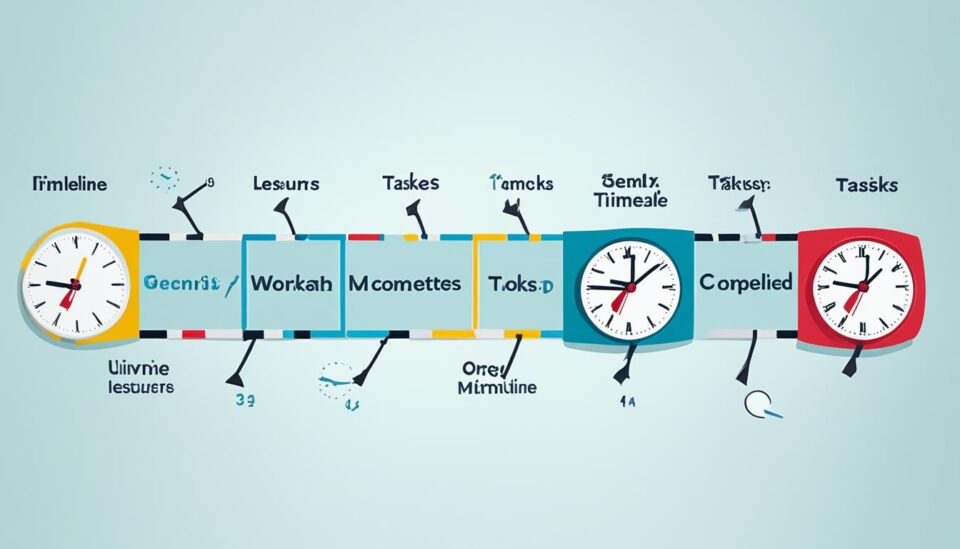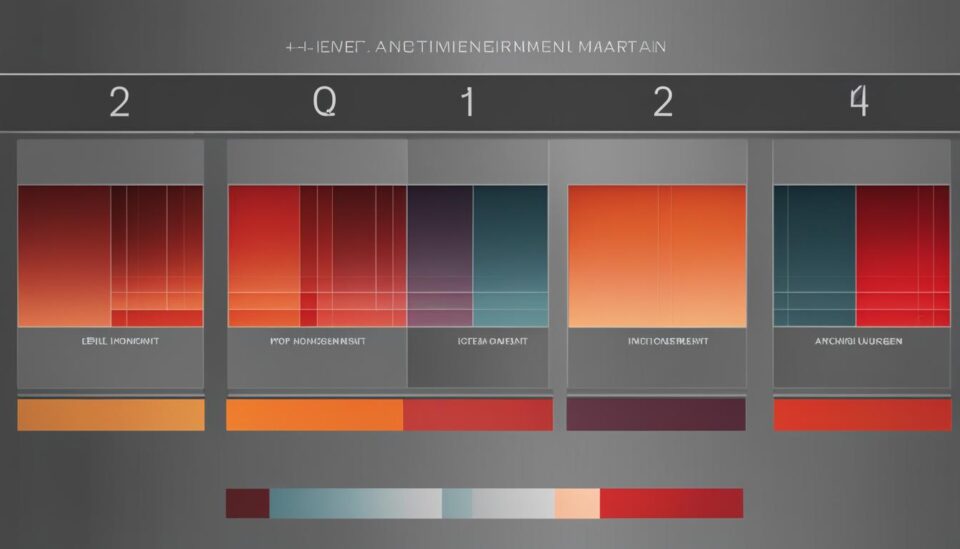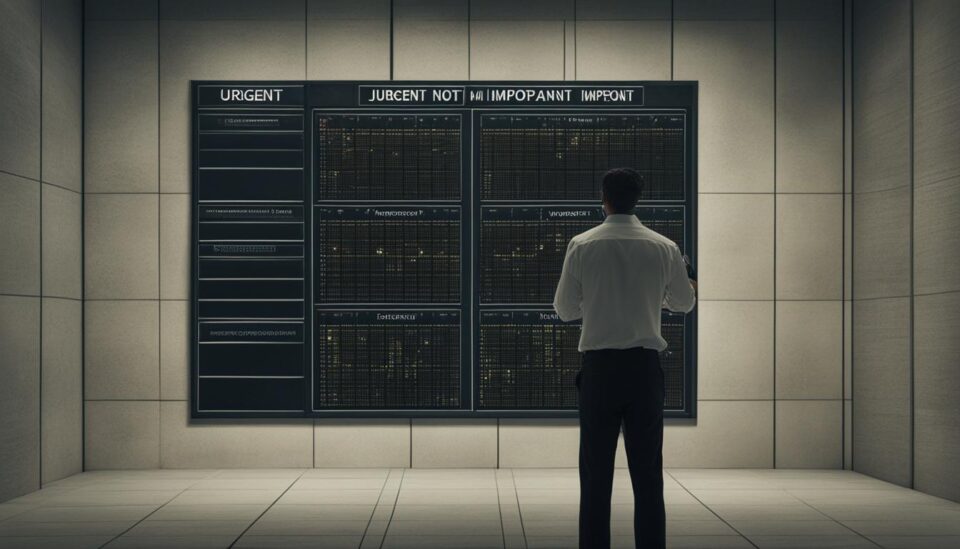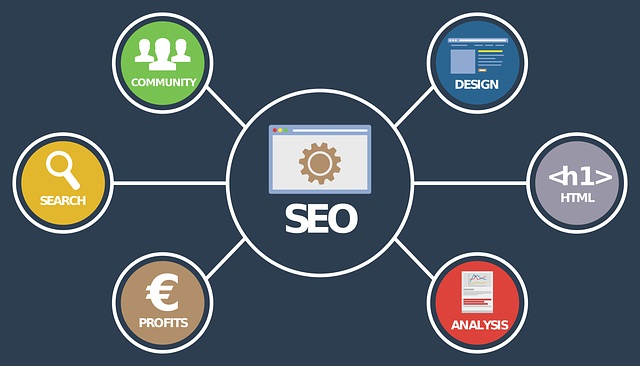Are you constantly struggling to organize your day and maximize your productivity? Do administrative tasks and procrastination eat up valuable time that could be better spent on strategic projects? If so, it’s time to master your day with effective time management techniques.
In today’s fast-paced business world, time is a precious resource. According to Starling Bank’s “2020 Make Business Simple” report, microbusinesses spend 15 hours every week on administrative work, which can be a significant drain on productivity. By implementing proven time management strategies, you can regain control of your day, increase work quality, reduce stress, and have more time for the things that truly matter.
So, how can you organize your day and become a more efficient and productive professional? In this article, we will explore a range of time management techniques and productivity hacks that can transform the way you approach your daily tasks and responsibilities. From knowing how you’re spending your time to setting reasonable time limits and prioritizing tasks, we will delve into the strategies that can help you take charge of your day and maximize your productivity.
Whether you’re a solopreneur, a small business owner, or an employee looking to enhance your time management skills, this article will provide you with valuable insights and practical tips to optimize your daily routine. Let’s dive in and discover the key techniques for organizing your day and achieving greater productivity.
Know How You’re Spending Your Time
![]()
Tracking how you spend your time is crucial for improving productivity. By understanding where your time goes, you can identify areas that need improvement and make necessary adjustments to optimize your productivity. One effective way to track your time is by using time-tracking tools.
Time-tracking tools like RescueTime offer valuable insights into how you allocate your time throughout the day. These tools provide detailed reports on the amount of time you spend on productive tasks versus non-work-related activities. By analyzing this data, you can gain a clear understanding of your productivity levels and identify any time-wasting habits or distractions that may be hindering your progress.
By keeping tabs on your time usage, you can take proactive steps to improve your efficiency and productivity. For example, if you notice that you spend a significant amount of time on social media or personal emails during work hours, you can set boundaries and allocate specific time slots for these non-work-related activities. This helps you maintain better focus and ensures that your work time is utilized effectively.
In addition, time-tracking tools can also help you evaluate the impact of your non-work-related activities on your overall productivity. While it’s important to take breaks and engage in activities unrelated to work, too much time spent on non-work-related activities can impact your productivity. By gaining visibility into how much time you allocate to these activities, you can strike a balance and make conscious decisions to optimize your time management.
Knowing how you’re spending your time is the first step towards enhancing productivity. By utilizing time-tracking tools, you can gain valuable insights, identify areas for improvement, and make informed decisions to optimize your workflow and achieve your goals.
Stick to a Daily Schedule

Creating a daily schedule is one of the key strategies for effective time management. By allocating specific time blocks for different tasks, you can ensure that you stay focused and organized throughout the day. It’s important to set realistic timelines for each task, taking into account the amount of time it will actually take to complete it. This helps prevent unrealistic expectations and allows for better planning.
Another important aspect of sticking to a daily schedule is incorporating time buffers between tasks. Unexpected delays and interruptions are bound to happen, so it’s crucial to leave some extra time to accommodate these unforeseen circumstances. By allowing for flexibility in your schedule, you can handle unexpected tasks or setbacks without derailing the rest of your day.
Self-discipline plays a vital role in adhering to a daily schedule. It’s crucial to resist the temptation of procrastination and avoid non-work-related distractions. Stay focused on the task at hand and avoid getting sidetracked by emails, social media, or personal matters during dedicated work time. Developing self-discipline takes practice, but it is a skill that can be mastered with perseverance and commitment.
Visualize your daily schedule as a roadmap that guides you through your tasks and responsibilities. Use productivity tools like calendars, task management apps, or project management software to help you stay organized and accountable. By following a structured daily schedule and staying committed to it, you can increase your productivity, achieve your goals, and maintain a healthy work-life balance.
Key Points:
- Create a daily schedule with specific time blocks for different tasks.
- Set realistic timelines for each task.
- Incorporate time buffers between tasks to account for unexpected delays.
- Practice self-discipline and avoid non-work-related distractions.
- Use productivity tools to stay organized and accountable.
Prioritize Tasks

Effective task prioritization is crucial for optimizing your productivity and managing your time efficiently. While to-do lists can be helpful in keeping track of tasks, they can also become overwhelming when not utilized strategically.
Enter the Eisenhower Matrix, a decision-making tool that helps you prioritize tasks based on their importance and urgency. This matrix allows you to categorize tasks into four distinct quadrants:
- Important and Urgent: These are tasks that require immediate attention and cannot be postponed. They should be your top priority.
- Important but Not Urgent: These tasks are important for your long-term goals but do not have an immediate deadline. Schedule time to work on these tasks to ensure they get the attention they deserve.
- Urgent but Not Important: Tasks in this quadrant may seem urgent and demand your immediate attention, but they do not contribute significantly to your goals. Delegate these tasks to free up your time.
- Not Important and Not Urgent: These tasks are neither important nor urgent and can be eliminated from your to-do list. They consume valuable time and should be avoided as much as possible.
By employing the Eisenhower Matrix, you can prioritize tasks effectively, focus on the most important and time-sensitive tasks, delegate tasks that can be done by others, schedule tasks for later, and eliminate tasks that do not align with your goals. This approach allows you to work efficiently and consistently towards your objectives.
Tackle the Most Difficult Task First

When it comes to effective time management, one popular method is the “Eat That Frog” approach. This productivity technique advises tackling the biggest and most challenging task first thing in the morning, ensuring that it doesn’t get postponed or pushed aside for later.
Procrastination can often derail our progress and lead to unproductive days. By addressing the most difficult task early on, we overcome the urge to delay it, build momentum, and set the tone for a productive day ahead.
The concept behind “Eat That Frog” is derived from the famous quote by Mark Twain, where he said, “Eat a live frog first thing in the morning and nothing worse will happen to you for the rest of the day.” The frog symbolizes the task that feels overwhelming or challenging, a task that we often tend to avoid due to its difficulty or discomfort.
By confronting the most demanding task head-on, we eliminate the anxiety associated with procrastination and gain a sense of accomplishment early in the day. Completing the most significant task first can also provide a boost of motivation and confidence, creating a positive domino effect for the remaining tasks on our to-do list.
To implement the “Eat That Frog” approach effectively, it’s crucial to identify the task that truly needs our immediate attention and action. This could be a high-priority assignment, a complicated project, or a task with tight deadlines. By dedicating focused time and energy to this task, we prevent it from looming over us, allowing us to work on it with concentration and dedication.
Benefits of Tackling the Most Difficult Task First
By incorporating the “Eat That Frog” technique into your time management strategy, you can experience various benefits:
- Overcoming Procrastination: By confronting the most challenging task early in the day, you reduce the tendency to put it off, thus minimizing procrastination.
- Increased Productivity: By completing the toughest task early on, you create a sense of accomplishment and motivation, leading to increased productivity throughout the day.
- Improved Time Management: Prioritizing the most important task ensures that it receives the attention and focus it deserves, helping you manage your time more effectively.
- Reduced Stress: Addressing the most demanding task first can alleviate stress and anxiety, enabling you to approach other tasks with a clear mind and reduced pressure.
- Enhanced Self-Confidence: Successfully tackling the most challenging task early in the day boosts your confidence and sets a positive tone for the rest of your tasks and responsibilities.
Implementing the “Eat That Frog” strategy may require discipline and perseverance initially, but as you make it a habit, you’ll find yourself becoming more efficient and effective in managing your time. By conquering the most significant task right at the start, you take control of your day, optimize your productivity, and achieve your goals with greater ease.
Batch-Process Similar Tasks

One of the key strategies for improving efficiency in time management is batch-processing similar tasks. Batching involves grouping tasks that have similarities and working on them consecutively. By doing so, you can minimize the time spent on task-switching and maximize your focus and productivity.
For example, you can schedule all client meetings on specific days, allowing you to allocate dedicated time blocks for uninterrupted client interactions. This not only streamlines your schedule but also enhances your ability to provide undivided attention during these meetings, ultimately improving client satisfaction.
Similarly, you can designate a specific time slot each day solely for responding to emails. By batching email responses together, you can avoid constant interruptions throughout the day, allowing you to concentrate on other important tasks that require full attention. This approach helps in clearing your inbox efficiently, ensuring that important messages are addressed promptly.
Another example of batch-processing is prioritizing the generation of reports during a particular time of day or week. By dedicating uninterrupted time for report preparation, you can focus your energy and creativity on efficiently analyzing data and creating comprehensive reports. This ensures accuracy and quality in your work, while also preventing constant interruptions from other tasks.
Batching tasks not only saves time but also enhances efficiency by allowing you to maintain a flow state. When you work on similar tasks consecutively, you can fully engage your skills and knowledge in that specific area, leading to better outcomes.
By adopting the practice of batch-processing, you can optimize your workflow, minimize time wastage, and increase productivity. Whether it’s scheduling meetings, responding to emails, or generating reports, grouping similar tasks together can help you work more efficiently and effectively.
Set Reasonable Time Limits

Parkinson’s law, which states that work expands to fill the time allotted to complete it, can have a significant impact on work efficiency. By setting reasonable time limits for tasks, you can increase productivity and prevent tasks from taking longer than necessary. Giving yourself smaller windows of time to complete tasks can help you meet earlier deadlines and avoid unnecessary delays.
When we have ample time to complete a task, we often tend to procrastinate or become less focused, leading to inefficiency. However, by setting specific time limits, we create a sense of urgency and encourage ourselves to work more efficiently. This not only helps us complete tasks faster but also allows us to allocate more time and energy to other important projects.
Setting reasonable time limits requires careful planning and consideration of the complexity and scope of each task. Break down larger projects into smaller milestones and allocate specific time blocks for each one. By dividing tasks into manageable segments, you can maintain focus and avoid feeling overwhelmed.
Furthermore, using techniques such as the Pomodoro Technique, where you work in short, focused bursts followed by brief breaks, can help you stay on track and maintain a high level of productivity. By working in concentrated periods, you give yourself a clear deadline, forcing yourself to work efficiently and complete tasks within the designated time frame.
By setting reasonable time limits, you can harness the power of Parkinson’s law to your advantage. Implementing this approach will not only increase work efficiency but also allow you to meet deadlines more effectively, leading to a more productive and successful work experience.
Learn When to Say No

Recognizing your limitations and setting boundaries is crucial for effective time management. It’s important to understand that you can’t do everything and be everywhere at once. By learning when to say no, you can conserve your energy and focus on tasks that align with your strengths.
Delegation is a powerful tool in time management. Identify tasks that can be done by others and delegate them accordingly. Whether it’s assigning tasks to team members or outsourcing certain responsibilities, delegating frees up your time for more important and high-value activities.
When you recognize your limitations and delegate tasks, you not only lighten your workload but also ensure that tasks are completed by individuals who are best suited for them. This allows you to prioritize tasks that align with your skills and expertise, leading to better outcomes.
Avoid Multitasking

Multitasking may seem like a way to get more done in less time, but research has shown that it actually decreases efficiency and increases the risk of errors. When we switch between tasks, there are “switching costs” involved, where our brain takes time to refocus and readjust to the new task. This constant task switching reduces productivity and can lead to decreased quality of work.
To maximize productivity, it’s important to avoid multitasking and instead focus on one task at a time. By dedicating your full attention to each task, you can complete them more efficiently and effectively. This allows you to give your undivided attention and apply your skills and knowledge to each task, resulting in better outcomes.
Instead of attempting to juggle multiple tasks simultaneously, prioritize your tasks and work on them in a sequential manner. Start with the most important or urgent task and complete it before moving on to the next one. This approach ensures that you give each task the necessary time and attention it deserves, leading to higher productivity and better results.
Keep Things Organized

Effective time management begins with organization. Organizing your workspace is crucial for maintaining focus and making sound decisions. A clean and clutter-free environment can help reduce distractions and enhance productivity.
One key aspect of organization is digital file management. Maintaining an organized computer file system ensures that you can easily locate and retrieve important documents and information when needed. By creating folders and subfolders with clear labeling and logical hierarchies, you can save time and avoid the frustration of searching through a cluttered digital space.
Additionally, using a calendar or scheduling tool can help you keep track of tasks, deadlines, and appointments. By allocating specific time slots for each activity, you can prioritize your workload and ensure that important tasks are completed on time.
Implementing organizational systems not only saves time but also reduces stress. When everything has a designated place and is easily accessible, you can work more efficiently and with greater peace of mind.
Benefits of Workspace Organization and Digital File Management:
- Improved focus: A clean and organized workspace allows you to concentrate better on the task at hand, reducing distractions and increasing productivity.
- Effective decision-making: When your workspace is organized, you can quickly access relevant information and make informed decisions without wasting time searching for necessary documents or files.
- Easy collaboration: Organized digital file management makes it easier to share files with colleagues and collaborate on projects efficiently.
- Reduced stress: Clutter and disorganization can cause unnecessary stress and anxiety. By keeping your workspace organized, you can create a calmer and more focused work environment.
Remember, organization is an ongoing process. Regularly review and declutter your workspace and digital files to maintain efficiency and optimize your time management efforts.
Use Time Management Tools

Leveraging productivity tools, communication tools, and collaboration tools can significantly enhance your time management skills, boosting productivity and streamlining workflow. These tools provide valuable features that help keep team communication organized, store and share files, manage schedules, and create professional-looking templates.
One essential tool for team communication is Slack. It allows you to create dedicated channels for different projects, making it easier to collaborate and share important updates. With Slack, you can have real-time conversations, share files, and integrate other productivity apps.
- Dropbox is another powerful tool that enables secure file storage and sharing. You can create folders for different projects, grant access to team members, and even collaborate on files in real-time. This ensures that everyone has access to the latest version of documents and eliminates confusion caused by multiple file versions.
- Google Calendar is a versatile tool for managing schedules, deadlines, and appointments. It allows you to create events, set reminders, and share calendars with colleagues. With Google Calendar, you can stay organized, plan your day effectively, and ensure you never miss an important meeting or deadline.
- Lucidchart is a collaborative diagramming tool that enables teams to create professional-looking flowcharts, mind maps, and diagrams. It provides an intuitive interface and a wide range of templates, making it easy to visualize complex processes and share them with team members for better understanding and collaboration.
By utilizing these time management tools, you can streamline communication, facilitate file sharing and collaboration, and create efficient workflows within your team. These tools enable you to stay organized, save time, and maximize productivity, ultimately leading to successful project outcomes.
Daily Schedule and To-Do Lists

Implementing a daily schedule and using to-do lists are fundamental time management strategies. Planning your day and prioritizing tasks helps you stay focused and productive, ensuring that important responsibilities are completed in a timely manner.
Creating a clear and structured plan for each day allows you to allocate specific time blocks for different tasks, making it easier to manage your workload effectively. By breaking down complex tasks into smaller steps and setting realistic goals, you can tackle them with more confidence and efficiency.
When developing a to-do list, prioritize your tasks based on their importance and urgency. This helps you identify critical tasks that require immediate attention and those that can be addressed later. By organizing your tasks in order of priority, you ensure that you allocate your time and resources appropriately.
A well-managed to-do list also allows you to track your progress and celebrate small victories along the way. As you complete tasks and check them off your list, you gain a sense of accomplishment and motivation to continue working towards your goals.
Benefits of a Daily Schedule and To-Do Lists
Implementing a daily schedule and utilizing to-do lists offer several benefits:
- Prioritizing Tasks: By ranking tasks according to their importance, you can focus on high-value activities that contribute to your overall goals and success.
- Effective Planning: Creating a structured daily schedule helps you allocate time and resources appropriately, ensuring that you have enough time for each task.
- Increased Productivity: With a clear plan and prioritized tasks, you can work efficiently, completing important tasks first and avoiding unnecessary delays.
- Reduced Procrastination: Having a detailed to-do list encourages action and minimizes the chances of procrastination, as you have a clear overview of what needs to be done.
- Improved Focus: A well-crafted schedule and to-do list help you stay focused on the task at hand, minimizing distractions and interruptions.
By implementing daily schedules and utilizing to-do lists, you can prioritize tasks effectively, plan your day efficiently, and increase overall productivity.
The Eisenhower Matrix

The Eisenhower Matrix is a powerful tool for effective task prioritization, focusing on urgent and important tasks. This matrix helps you categorize tasks into four quadrants, allowing you to allocate time and resources efficiently.
Here’s how the Eisenhower Matrix works:
- Urgent and Important: Tasks that are both urgent and important should be given the highest priority. These tasks require immediate attention and have a significant impact on achieving your goals. Allocate dedicated time and resources to complete them promptly.
- Important, but Not Urgent: These tasks are important for long-term success but do not have an immediate deadline. To ensure they receive adequate attention, schedule specific time blocks to focus on these tasks. By proactively addressing them, you can avoid them becoming urgent and maintain control of your schedule.
- Urgent, but Not Important: Tasks that are urgent but not important tend to consume a significant amount of time without contributing much to your overall goals. Evaluate whether these tasks can be delegated or eliminated altogether. Delegating such tasks allows you to focus on higher-value activities that align with your expertise and priorities.
- Not Urgent and Not Important: These tasks provide little to no value in achieving your goals. Eliminate or minimize these tasks as they often serve as distractions and hinder productivity. Saying no and avoiding time-wasting activities is crucial for effective task management.
By using the Eisenhower Matrix, you can prioritize tasks effectively, ensuring that urgent and important tasks receive the attention they deserve. This approach helps you make informed decisions, allocate your time wisely, and focus on tasks that have the greatest impact on your success.
Overcoming Procrastination

Procrastination can be a significant obstacle to productivity and effective time management. Many individuals struggle with task avoidance, finding it difficult to start or complete tasks in a timely manner. To overcome procrastination and improve your time management skills, it is important to implement specific strategies and techniques. By addressing the root causes of procrastination and finding ways to stay motivated and reward progress, you can enhance your productivity and achieve your goals.
One effective strategy to combat procrastination is to tackle the “big frog” first. This means taking on the most challenging and important task at the beginning of your day. By accomplishing this task early on, you set a positive tone for the rest of the day and alleviate the stress and anxiety associated with procrastination. Breaking tasks into smaller segments can also help overcome the feeling of overwhelm and make them more manageable.
Implementing reward systems for completed tasks can provide the motivation needed to overcome procrastination. Whether it is treating yourself to a small reward after completing a task or setting milestones for larger rewards, the act of rewarding progress reinforces positive behavior and creates a sense of accomplishment. This can help you stay motivated and focused on your tasks.
Understanding the root causes of procrastination is essential for effective management. Some common reasons for procrastination include fear of failure, lack of clarity about tasks, perfectionism, and feeling overwhelmed. By addressing these underlying issues, such as setting realistic expectations and breaking tasks into smaller, actionable steps, you can overcome procrastination and boost your productivity.
Managing Time-Wasters

Effective time management involves identifying and reducing activities that waste time and hinder productivity. Two common sources of time-wasting are excessive use of handheld devices and ineffective email management. By implementing strategies to address these issues, you can reclaim valuable time and enhance your overall efficiency.
Reduce Distractions from Handheld Devices
Handheld devices, such as smartphones and tablets, can be significant sources of distraction. Constant notifications, social media apps, and mindless scrolling can consume precious time and disrupt your workflow. To minimize distractions from handheld devices:
- Mute non-essential notifications or customize them to filter only important ones.
- Utilize screen time limits or app timers that restrict your access to time-wasting apps.
- Use productivity apps that block distracting apps or websites during specific periods.
Implement Effective Email Management
Email can be a time-consuming task if not managed properly. To streamline your email management and prevent it from becoming a time-wasting activity:
- Set aside dedicated time slots during your day to check and respond to emails, instead of constantly checking your inbox.
- Utilize email filters and labels to organize incoming emails and prioritize them based on their importance.
- Use email templates for commonly sent emails to save time on composing repetitive messages.
- Consider using voice-to-text features to respond to emails quickly and efficiently.
By implementing these strategies, you can significantly reduce time wasted on non-essential handheld device usage and ineffective email management. These small adjustments will help you stay focused, minimize distractions, and increase your overall productivity.
Delegate and Get Help
Effective time management involves recognizing when to delegate tasks to others and seeking help when needed. By entrusting certain responsibilities to capable individuals, you can free up your valuable time for more important and high-value activities.
Identifying tasks that can be done by others is a crucial aspect of task delegation. Evaluate the skills and expertise of your team or consider partnering with external professionals who specialize in specific areas. Selecting the right individuals to handle these tasks not only ensures their successful completion but also improves overall time management.
In addition to task delegation, outsourcing certain activities or availing time-saving services can also contribute to better time management. By leveraging the expertise of external service providers, you can streamline your workflow and reduce time spent on non-core tasks. This enables you to focus on strategic initiatives and core business activities that drive productivity and growth.
Remember, effective time management is not just about working harder, but also about working smarter. By delegation, outsourcing, and accessing time-saving services, you can maximize your productivity, optimize your workflow, and achieve better results.
 Sharing is Caring Blog Something different…
Sharing is Caring Blog Something different…









